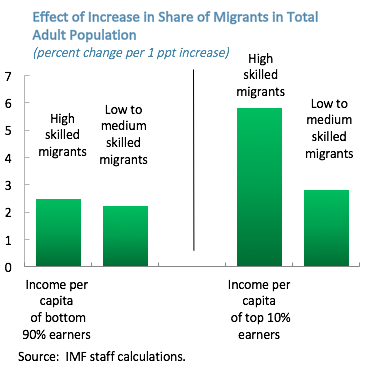According to The New York Times,
President Trump on Wednesday began a sweeping crackdown on illegal immigration, ordering the immediate construction of a border wall with Mexico and aggressive efforts to find and deport unauthorized immigrants. He planned additional actions to cut back on legal immigration, including barring Syrian refugees from entering the United States.

The four remaining draft orders obtained by Vox focus on immigration, terrorism, and refugee policy. They wouldn’t ban all Muslim immigration to the US, breaking a Trump promise from early in his campaign, but they would temporarily ban entries from seven majority-Muslim countries and bar all refugees from coming to the US for several months. They would make it harder for immigrants to come to the US to work, make it easier to deport them if they use public services, and put an end to the Obama administration program that protected young “DREAMer” immigrants from deportation.
In all, the combined documents would represent one of the harshest crackdowns on immigrants — both those here and those who want to come here — in memory.
Much like trade, I’ve spent the last year writing about the economics of immigration. Some of my findings are:
- Dropping all immigration restrictions would double world GDP.
- Even liberal reforms–such as would allow 10% of the world population to move–would increase global output by 14 percent.
- Migrants contribute nearly 10% of global GDP. Integrating migrants more effectively could lead to a $800 billion to $1 trillion boost to worldwide economic output.
- The chance of being killed by a foreign terrorist on American soil is extremely low. In fact, immigrants commit crimes at lower rates than the native population.
- Legalizing undocumented workers would boost private-sector GDP.
- Immigration may actually improve economic and political institutions (i.e., increase economic freedom).
- Cultural diversity boosts economic growth.
- Immigrants can actually create local jobs and raise native wages.
- Refugees increase total real income in the areas they are located.
- A large percentage of immigrants are entrepreneurial.
- Immigrants bring intact families.
- Immigrants do not have negative effects on native wages or employment. They do boost economic growth, increase consumer demand, and reduce prices of some goods and services.
Sure enough, more evidence comes rolling in. A new IMF study finds
that migrants help increase per capita income levels in host advanced economies, and this effect is both statistically and economically significant. Our estimates suggest that a one percentage point increase in the share of migrants in the adult population (the average annual increase is 0.2 percentage point) can raise GDP per capita by up to 2% in the long run. Moreover, this effect comes mainly through an increase in labour productivity and, to a lesser extent, through the more standard channel of an increase in the ratio of working-age to total population.
The result survives a number of robustness checks, which include controlling for other determinants of income per capita (trade openness, the level of technology, the education level, and age structure of the host population, and policy variables); excluding from the sample countries that were created through migration and have high income levels (USA, Canada, Australia, and New Zealand); and using alternative gravity model-based instruments.
We find that both high- and low-skill migrants raise labour productivity. There is no evidence of major physical or human capital dilution, as investment adjusts over time to the larger pool of workers, and migrants are increasingly high-skilled. Instead, our results suggest that the complementarities that earlier analyses uncovered mostly at the micro level are also relevant at the macro level. The evidence from the microeconomic literature suggests that the positive productivity effects come from increased TFP and human capital. High-skilled migrants contribute to productivity directly, including through innovation, and indirectly through their positive spillovers on native workers. Low- and medium-skilled migrants can also contribute to aggregate productivity, to the extent that their skills are complementary to those of natives, promoting occupational reallocation and task specialisation.
…Our analysis finds…that the gains from immigration are broadly shared across the population. Migration increases the average income per capita of both the bottom 90% and the top 10% of earners, even though high-skilled migration benefits more top earners — possibly because of a stronger synergy between migrants and natives with high skills. Moreover, the Gini coefficient — a broad measure of income inequality within the bottom 90% of earners — is not affected by the migrant share.
Let them come.
